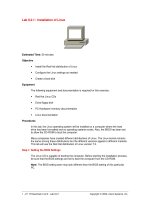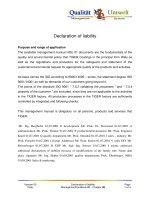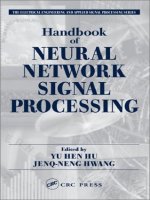Tài liệu Secret of power ppt
Bạn đang xem bản rút gọn của tài liệu. Xem và tải ngay bản đầy đủ của tài liệu tại đây (119 KB, 3 trang )
power
Powering a home appliance is simple. There are no choices to
make. Power for your network, on the other hand, never has been
more complicated. And in today’s competitive environment, the issues
are not only technical; there are business considerations as well:
• Obviously, power distribution systems must be effective. But
this means more than delivering the required amperage. They also
must be easy to configure, install and maintain.
• Power distribution systems have to be reliable. They should
deliver power continuously with a minimum of trouble over the
longest possible life.
• Equipment must be safe—safe for the network and facilities and
safe for the installers and technicians who work with them.
• Installations should be economical. This is not just a matter of
comparing purchase prices. Cost can increase by the need for excess
“real estate” or maintenance or by the loss of revenue because of fail-
ure.
• Finally, there are time considerations. In fast-moving markets,
decisions must be made and implemented quickly. Service providers
must be able to balance the previously mentioned criteria with little
time for deliberation or experimentation. And once choices have
TELEPHONY • www.internettelephony.com • April 24, 2000
POWER
C
heck the troubleshooting guide for any electri-
cal appliance, and the first question will prob-
ably be, “Is it plugged in?” Go ahead and laugh
(unless you’re the red-faced guy reaching for the plug),
but the point is plain: Electrical devices need power. And
if the device is part of a critical communications system,
problems with power definitely can be serious.
Secrets of
Secrets of
With all the variables
to consider when
installing a power system
for your network,
at least one thing is clear:
It ain’t as easy
as plugging in a toaster
by D
AVID
S
CHOMAKER
With all the variables
to consider when
installing a power system
for your network,
at least one thing is clear:
It ain’t as easy
as plugging in a toaster
been made, equipment must be available when needed.
It doesn’t take much delay for customers to exercise
their newfound freedom of choice by going elsewhere
for service.
Complicated networks, complicated power
Consumer appliances are simple. You can take your dig-
ital clock radio anywhere: home or office, Boston or
San Diego. Plug it in, set it and it runs. You also can plug
a different home appliance into the same socket, and it
still will work. All the complicated work already is done.
From the wall-socket in, credit the power company
(for providing standardized 110 V, 60 Hz service) and
the electrician (for using standard outlets and wiring to
code). From the plug out, the appliance manufacturer is
responsible for equipping the device with circuitry that
adjusts the current up or down as needed to power var-
ious appliances.
Powering telecom devices is far more complex. The
power company delivers AC voltage. The equipment
supplier provides DC devices. The transition is up to
you, and that’s where things get complicated. You could
be installing any type of equipment, from wired—or
wireless—transmitters to multiplexers or routers. It
could be located in a central office (CO) or at a remote
location—a controlled environmental vault, hut or out-
side plant cabinet. Mountings vary, as do requirements,
for -48 or -24 VDC (Figure 1).
Playing it safe
All doctors must take the Hippocratic Oath, the point of
which is to do no harm. The same rule might be applied
to power systems—and for good reason. Electricity is
the genie in the bottle. Properly managed, it does our
chores, but when it goes where it doesn’t belong, it can
injure or destroy. None of this would be a problem if all
installations were alike (they aren’t); the professionals
working with them had all the time in the world (they
don’t); and systems were installed in unchallenging en-
vironments (they’re not).
In the real world, power distribution systems have to
be custom configured to their applications. They are
installed and maintained by busy technicians with
schedules to keep. They are located in COs and in
remote locations. And despite our best efforts, they can
be subject to every kind of shock and insult, from water
leakage to earthquakes. Considering the risks, there’s
only one sensible solution: constructive paranoia.
Research may suggest that optimists live longer,
happier lives, but to ensure long happy lives for net-
works and the people who maintain them, it pays to
ask, “What could go wrong?”
History is full of “impossible”
occurrences. If Hannibal could
drive elephants over the Alps, you
can assume that someone, someday,
will fail to close the water-resistant
door of your hut or cabinet, expos-
ing your powering equipment to the
elements. Someone will drill a hole
into your wall. And your best-
trained technician will, someday,
reach in someplace he shouldn’t.
The question is not whether things
will go wrong. Rather, the question
is how soon—and how often.
Several steps can be taken to pre-
pare for the inevitable:
• Choose a single power distribu-
tion platform for your entire net-
work. Don’t make your technicians
learn two or three different ones.
Even if individual installations are
customized, the same basic struc-
ture will simplify training proce-
dures, allowing technicians to develop and follow safe
routines. Purchasing and inventory management also
will become simpler.
• If wiring and electronic elements shouldn’t be
touched, make sure that they are adequately covered
and labeled.
• If single-post grounding is good, two-post ground-
ing is better.
• Don’t cut corners. Fire, injury and loss of service
can be disruptive and expensive enough to offset any
savings you may have realized.
Something for the optimists
With all this talk of things that could go wrong, it may
seem impossible to choose the right product. That’s why
there are standards. Standards bodies collect the experi-
ence of experts and apply them to products. Power sys-
tems for telecom are, in fact, some of the most rigor-
ously tested and standardized of all products. By
April 24, 2000 • www.internettelephony.com • TELEPHONY
POWER
POWER DISTRIBUTION SCENARIOS
Primary power
distribution
Power equipment
Incoming
AC power
AC power
distribution
Batteries
Rectifiers
Fuse panel
DC-powered
equipment
DC-powered
equipment
Source: ADC
Secondary power
distribution
(power distribution panel)
FIGURE 1
demanding the highest levels of standards-compliance
in the products you use, you avoid unnecessary prob-
lems.
The approvals you should look for include:
• UL (Underwriter’s Laboratories). This is a safety
standard for electrical products
• NEBS (network equipment building standards)
Level 3. NEBS Level 3 is the highest of three levels of
safety and operability under worst-case conditions,
including Zone 4 earthquake protection. NEBS Level 3
is required of most power products purchased by
incumbent carriers, and it is being embraced by other
North American carriers. Look for 100% independent
testing (as opposed to vendor self-testing) to this stan-
dard.
• NEC (national electrical code). NEC is written by
the National Fire Protection Agency and must be car-
ried by any product connected to a U.S. telecom net-
work. NEC 1999 is the most recent version of this
standard.
• CE (Conformité Européenne) and IEC (International
Electro-technical Committee). CE is a requirement for all
telecom equipment sold in the European Union. Stan-
dards cover person-
al safety, protection
of public networks,
interoperation with pub-
lic network equipment and
electromagnetic compatibility. IEC
writes global standards of a similar
nature. Look for approvals from both
bodies.
One final thought on the subject:
There is no excuse for failure to fully
comply with applicable standards.
Ease of use
Power systems don’t exist in a vac-
uum. They are installed by real peo-
ple in real places. Product design
can make that process easier, safer
and more economical. As already
mentioned, standards compliance is
a good start, but there’s more that
can be done.
A single, configurable system of
components provides the consisten-
cy that installers need to work
quickly, effectively and safely.
Flexibility in configuration lets
them tailor each installation to the
application and environment in
which it is installed. A system that
automatically adjusts for voltage
and polarity requirements further
simplifies the process. And the ability to “one-stop-
shop” eases purchasing.
Telecom applications can present unique problems,
such as tight fits in crowded locations. Seemingly small
features such as high-visibility fuses and LEDs, flexible
mounting options and field-replaceable parts can speed
and simplify field work, while reducing danger and dis-
comfort for personnel. Clear plastic covers provide an
extra margin of safety without reducing visibility of
input/output power connections (see sidebar).
Reliable, safe power is critical to the network.
Absolute compliance with applicable standards is the
least you should expect. Also, look for a system that is
comprehensive, easy to configure and deploy and reli-
able. Especially in today’s competitive telecom market,
be aware that seemingly small matters can impact oper-
ations, performance and, ultimately, revenue. When it
comes to safety, flexibility, simplicity and reliability,
don’t hesitate to make the necessary investment. You’ll
profit over the life of the network.
David Schomaker is the Senior Product Manager of PowerWorx products for
the Broadband Connectivity Group at ADC Telecommunications in
Minneapolis. His e-mail address is
POWER
Power rules
P
owering telecommunications networks never will be
easy, but the process can be simplified by following
some practical rules:
❍ Absolute standards compliance, including indepen-
dent NEBS (network equipment building system) Level 3
testing. This can be especially critical for competitive local
exchange carriers co-locating equipment with incumbent carri-
ers. Incumbents tend to be strict about standards compliance.
❍ High input power per bus. This allows flexibility in the deployment
and helps hold down the cost of systems, labor and real estate.
❍ Flexibility of voltage and polarity. The ability to handle -48 or -24 VDC
applications on the same type of panel provides the consistency that
makes a technician’s work easier and safer.
❍ Flexibility of mounting. Panels that can fit either 19- or 23-inch racks
can reduce inventory and cost. Choice of front/rear or all-front access
simplifies deployment.
❍ Density. As in all installations, density reduces the need for expen-
sive real estate, especially in remote locations. In power distribution, for
example, the ability to install GMT fuses without spacing can make a big
difference.
❍ Ease of ordering. Systems that can be “configured-to-order” in terms
of power input/output, fuse management, mounting, etc., are faster and
simpler to tailor to applications throughout the network. Better fit means
better operation and lower cost.
❍ Speed of delivery. The best equipment is useless if it isn’t where you
need it, when you need it. Choose a vendor with proven delivery capability.
❍ Choose a vendor with proven telecom experience. An experienced
vendor will understand your network, and you’ll be able to leverage this
experience to your benefit.
❍ Expect more than just a product. Look for a vendor to provide techni-
cal support, information, documentation and, if desired, engineer, furnish
and install services.
❍ Look for a solid warranty—the longer the better.
Reprinted with permission from the April 24, 2000, issue of
Telephony
.
®
Copyright 2000, Intertec Publishing, A PRIMEDIA Company, Overland Park, KS. All rights reserved.









